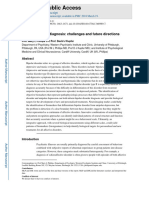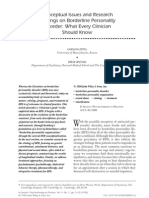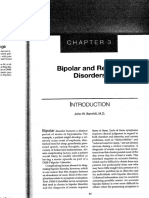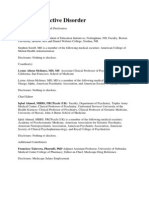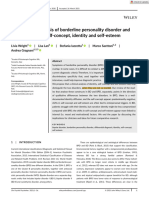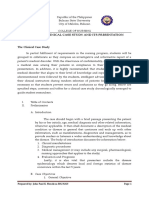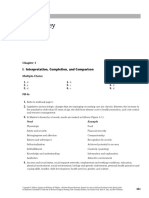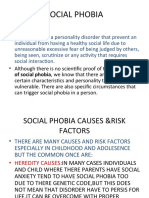Kernberg 2013
Uploaded by
Facturas PaulinaKernberg 2013
Uploaded by
Facturas PaulinaDifferential diagnosis
Kernberg and Yeomans
Borderline personality disorder,
bipolar disorder, depression,
attention deficit/hyperactivity disorder,
and narcissistic personality disorder:
Practical differential diagnosis
Otto F. Kernberg, MD
Frank E. Yeomans, MD
The challenge of accurate diagnosis remains at the heart of good
psychiatric treatment. In the current state of psychiatry, a confluence
of forces has increased this challenge for the clinician. These include
practical pressures—such as limited time for diagnostic evaluation,
the question of what is reimbursed by insurance, and the issue of
directing patients to acute treatments—and also trends in nosology,
such as the descriptive focus on signs and symptoms in the cur-
rent official diagnostic system. The authors offer observations that
we hope will help clinicians who have to make difficult diagnostic
differentiations often under pressured circumstances. The paper is
motivated both by the high frequency of diagnostic errors observed
under such conditions and also by the belief that considering sym-
ptoms in the context of the patient’s sense of self, quality of interper-
sonal relations, and level of functioning over time will help guide the
diagnostic process. (Bulletin of the Menninger Clinic, 77[1], 1–22)
Dr. Kernberg is Director, Personality Disorders Institute, The New York Presbyterian
Hospital, Payne Whitney Westchester; Professor of Psychiatry, Joan and Sanford I.
Weill Medical College of Cornell University; and Training and Supervising Analyst,
Columbia University Center for Psychoanalytic Training and Research. Dr. Yeomans
is Clinical Associate Professor of Psychiatry at the Weill Medical College of Cornell
University; Director of Training at the Personality Disorders Institute at the New York
Presbyterian Hospital, Payne Whitney Westchester; and Director of the Personality
Studies Institute in New York City.
Correspondence may be sent to Dr. Otto Kernberg, New York Presbyterian Hospital,
21 Bloomingdale Rd., White Plains, NY 10605; e-mail: OKernber@med.cornell.edu.
(Copyright © 2013 The Menninger Foundation)
Vol. 77, No. 1 (Winter 2013) 1
Kernberg and Yeomans
What follows are clinical observations directed to psychiatrists
who have to make difficult diagnostic differentiations, often un-
der circumstances of pressured time. These differentiations often
involve decisions regarding immediate interventions and treat-
ment planning. This article is motivated by the high frequency of
diagnostic errors observed under such conditions, an observation
that emerges only when the patient is seen under more stable con-
ditions, particularly during more extended evaluation. We shall
not review systematically the diagnostic criteria for the various
conditions to be jointly explored, but only highlight those aspects
of mental status examination that facilitate a differential diagno-
sis under the conditions mentioned.
We have observed that about 50% of patients who enter the
personality disorders unit of our hospital with the diagnosis of
bipolar disorder or major depression turn out to present neither,
but rather a severe personality disorder organized at the border-
line level (Kernberg, 1975, 1984), particularly borderline person-
ality disorder (BPD), severe narcissistic personality disorder, or
various disorders in which recurrent suicidal ideation, parasui-
cidal traits, and/or antisocial behavior are the main symptoms,
or where an acute drug dependency or alcoholism dominates the
picture. Erroneous diagnostic conclusions have frequently been
reached, particularly in the case of patients with strong negativis-
tic features, who refuse or are unable to provide adequate infor-
mation about themselves, or, occasionally, may wish to exagger-
ate certain symptoms in order to obtain hospitalization.
Bipolar disorder
The clinical range of bipolar illness remains a subject of de-
bate (Paris, 2009). The diagnosis of a bipolar disorder requires,
in DSM-IV-TR, the presence of at least one episode of a major
depression and one manic (Bipolar I) or hypomanic (Bipolar II)
episode. The accurate assessment of the presence of manic or hy-
pomanic episodes is essential. The experience of multiple prior
evaluations may predispose patients to give a history that fits a
manic or hypomanic episode because of the standard nature of
questions asked, and we have frequently observed some patients’
2 Bulletin of the Menninger Clinic
Differential diagnosis
tendency to conform to questions that have a “leading” quality
with regard to standard manic or depressive symptoms. It is im-
portant to patiently ascertain whether the patient has indeed had
one or several periods of at least 3 to 4 days in which an unusu-
ally euphoric, angry, or irritated mood predominated, together
with a sense of heightened energy, affective dyscontrol, signifi-
cantly reduced need to sleep, hyperactivity, and unusual behavior
in sharp contrast to the usual personality of the patient. Such
behavior may involve inappropriate sexual exposure or behavior,
grave mismanagement of money or other properties, socially in-
appropriate approaches to others, and possibly increase of sexual
drive together with a general expansiveness of mood and behav-
ior. Symptoms of a true manic episode often involve loss of real-
ity testing as manifested by behavior that does not correspond to
socially accepted norms without awareness of the deviation from
the norm.
The most frequent mistake, in our experience, consists in con-
fusing the chronic emotional instability and affect storms of per-
sonality disordered patients with a truly hypomanic or manic be-
havior. In the case of manic behavior, the differentiation is easier;
here the clear loss of reality testing, the presence of hallucinations
and/or delusions, or inappropriate social behavior usually leads
to intervention by others to control the patient, interventions that
are typical enough to confirm loss of reality testing and to war-
rant the diagnosis of a bipolar disorder. Therefore, the confusion
between bipolar illness and BPD is usually reduced to cases of as-
sumed hypomanic behavior used as the basis to diagnose bipolar
II in patients.
In about 19% of patients with borderline personality disorder,
however, a comorbidity with bipolar disorder may be present,
and the patient shows both severe, chronic affective instability
and clear hypomanic episodes (Gunderson et al., 2006). To as-
certain the presence or absence of BPD in these cases, it is help-
ful to evaluate the general nature of the patient’s relationships
with significant others. Cases of pure bipolar symptomatology
do not show severe pathology of object relations during periods
of normal functioning, and even chronic bipolar patients, who
suffer from both manic episodes and major depressive episodes,
Vol. 77, No. 1 (Winter 2013) 3
Kernberg and Yeomans
maintain the capacity for relationships in depth, stability in their
relations with others, and the capacity for assessing themselves
and the most significant persons in their life appropriately (Stone,
2006).
In contrast, in severe personality disorders with the syndrome
of identity diffusion, there is a marked incapacity to assess oth-
ers in depth, a lack of integration of the concept of self, with
severe, chronic discrepancies in the assessment of self and others,
and chronic interpersonal conflicts, together with the difficulty of
maintaining stable commitments to work and profession as well
as to intimate relationships.
The combination of absence of affective stability, absence of
significant and mature relations with others, and instability in
work or profession, in love relations, and in self-assessment con-
firms the diagnosis of a severe personality disorder even if, at the
same time, bona fide symptomatology of a bipolar I, or bipolar
II type is effectively present. In short, the presence of a consistent
and marked immaturity of all object relations, and emotional im-
maturity in general, outside bona fide episodes of manic, hypo-
manic, or depressive symptomatology is characteristic of border-
line personality disorder.
The therapeutic implications of this differentiation reside in
the essential indications of psychopharmacological treatment
with mood stabilizers in the case of bipolar patients and, in gen-
eral, in major affective illness, in contrast to the predominant re-
quirement for appropriate psychosocial and psychotherapeutic
interventions in the case of severe personality disorders (Ameri-
can Psychiatric Association, 2001).
Major depressive episode
The differential diagnosis between an episode of major depres-
sion and a chronic dysthymic reaction in borderline personality
disorder is more difficult, but eminently feasible—if enough time
is available to clarify the four major areas of symptoms.
First are the psychic symptoms of a depressive spectrum of ill-
ness. In major depressions, there is a significant slow-down of
the patient’s thought processes and the patient’s psychomotor
4 Bulletin of the Menninger Clinic
Differential diagnosis
behavior, severe depression of mood that varies between pro-
found sadness to the total unavailability of any subjective sense
of feeling—a sense of total freezing of all emotional experience
in the most severe cases. Typically, thought processes are severely
self-demeaning and self-accusatory—rather than focused on ac-
cusing and blaming others. The patient may present severe guilt
feelings that may range from chronic exaggeration of whatever
real deficits or faults the patient has detected in himself or her-
self to extreme, delusional self-devaluations and self-accusations.
This combination of chronic slowing down in behavior, lowering
in mood, and self-devaluation over a period of weeks to several
months, combined with consistent daily fluctuations of symp-
toms—the patient feeling worse in the mornings and mood im-
proving gradually every evening, with a relentless repetitiveness
of such daily cycles over weeks—characterizes a typical major
depressive episode.
While it may be clear that these symptoms are typical of a
major depressive episode, in our experience, many patients tend
to respond to the routinized questions on hurried mental status
examinations in a way that conveys the impression to the exam-
iner that they suffer from this syndrome. The clinicians and/or
the patients wish to diagnose an Axis I condition because these
conditions fit more readily into acute treatment plans based on
pharmacological interventions and also have less stigma than per-
sonality disorders. Frequently patients may state that they feel
chronically hopeless and helpless, which would reflect a total
depressive despondency. However, when one asks patients what
they feel hopeless about and in what way do they feel helpless,
patients have difficulty conveying a response that is harmonious
with a general self-devaluation, and, to the contrary, in the case
of severe personality disorders with characterologically based
dysthymic reactions, patients may respond with accusations and
rage against others with an affect that seems more angry than
depressed.
This predominance of rageful reactions while professing total
self-devaluating depression is quite characteristic of personality
disorders, and should raise questions about the assumed major
depression. In the case of major depressions, patients withdraw
Vol. 77, No. 1 (Winter 2013) 5
Kernberg and Yeomans
from social contacts and may feel worse when efforts are made to
stimulate them to socialize; premature efforts of encouragement
may have the opposite effect and, in fact, increase suicidal tenden-
cies in patients with major depression. The depressive reactions
in personality disorders are usually less severe and are irregular
in their appearance and duration. They may shift abruptly from
one day to the next, even from one hour to the next, and are
clearly influenced, in positive or negative ways, by the patient’s
immediate social environment. Shifts of the symptomatology ac-
cording to different social circumstances—for example, if the pa-
tient is apparently more deeply depressed during the week but on
weekends, in the presence of friends, engages in animated social
interactions, only to reverse to a state of depression on the fol-
lowing days—are characteristic of a personality disorder with a
characterological depression—dysthymic disorder1—and not of a
major depression.
In general, the patient’s gross physical neglect of appearance,
the incapacity to carry out ordinary activities of daily living, stay-
ing in dirty clothes, and indicating an unusual neglect of his or
her appearance are more characteristic of a major depression in
the context of all the psychic symptoms mentioned. Again, the
patient’s rapid shifting in behavior under conditions of desirable
social interactions is more characteristic of the symptoms of char-
acterological depression in a personality disorder.
A second area of exploration of the differential diagnosis is
the evaluation of the personality structure that predated the be-
ginning of the depressed episode. Patients with severe narcissistic
personality disorder, borderline personality disorder, histrionic
personality disorder, and masochistic/depressive personality dis-
order are prone to severe dysthymic reactions characterized by
frequent days with symptoms of depression without reaching the
intensity, consistency, and duration of major depressive episodes.
In these cases, there is usually a history of chronic minor depres-
sive episodes or dysthymic reactions extending over many years,
a lack of clear periods of at least months’ duration in which the
patient evinced no depression at all, so that dysthymic symptoms
have acquired a relative stability in the psychic equilibrium of
1. A prevalent form of chronic, characterologically based depression.
6 Bulletin of the Menninger Clinic
Differential diagnosis
such patients. There are patients who report that they have been
depressed all of their lives, and these patients usually present se-
vere personality disorders. But these symptomatic features have
to be differentiated from the characterological features of the
masochistic/depressive personality. However, a certain percentage
of patients with major depression, probably around 30%, may
become chronic with refractory depression persisting over many
years (McGrath & Miller, 2008; Rush et al., 2006). These re-
fractory cases may present well-documented symptoms of major
depression and a remarkable lack of response to all psychophar-
macological and other, physical treatment interventions. With
electroconvulsive treatment, some of these patients may signifi-
cantly improve for several weeks and then often revert to chronic
depression again. It is especially important to make a correct di-
agnosis in such cases because some patients with “refractory”
depression may have a characterological depression that would
benefit from appropriate psychotherapy, and it is important to
differentiate these latter features in cases of “double depression.”
Gunderson et al. (2004) found that the rate of remission from
major depressive disorder was significantly reduced in cases with
co-occurring BPD. However, the rate of remission from BPD was
not affected by co-occurring major depressive disorder.
A third area of inquiry facilitating the differential diagnosis
between major depression and characterologically based dysthy-
mic reactions involves the following neurovegetative symptoms
that point to major depressions: severe insomnia, particularly
consistent early awakening hours before the usual waking time;
loss of appetite with severe weight loss; consistent loss of sexual
desire; possibly impotence in men and suspension of menstru-
al periods in women; chronic, severe constipation (considering,
naturally, that this may be secondary to the use of antidepressive
medication); a heightened sensitivity to cold temperature and, in
severe cases, a typical “mask like” facial expression of severe de-
pression. There are patients with atypical major depression for
whom the depressed mood is worse in the evenings rather than
in the mornings, and who present a tendency to hyperphagia and
gaining weight. These cases have to be evaluated very carefully
regarding the psychic symptoms of depression mentioned ear-
Vol. 77, No. 1 (Winter 2013) 7
Kernberg and Yeomans
lier before reaching a definite conclusion. Patients with genetic
predisposition to affective disorders may show neurovegetative
symptoms even under conditions of relatively lighter depression
within the frame of a major depressive illness.
A fourth area of diagnostic relevance for the evaluation of de-
pression is the analysis of environmental triggers that may have
preceded a depressive episode. Typically, in chronic dysthymic,
characterological reactions, environmental conditions may trig-
ger depressive reactions, and these environmental conditions are
often remarkably minor, while the patient pays a disproportion-
ate attention to their symbolic value. Major depressions usually
do not show such a direct relationship between environmental
triggers and depression, although the combination of strong ge-
netic disposition and environmental triggers can occur.
In conclusion, regarding these four areas of inquiry, the more
severe the psychic symptoms and the neurovegetative symptoms,
the more likely there is a major depression; the more predomi-
nant the personality disposition and the environmental triggers,
the more likely there is a dysthymic disorder (characterological
depression). There are patients, however, who present a “double
depression,” that is, an acute episode of a major depression in
the context of a chronic characterological depression. These cases
require, first, the treatment of the episode of major depression.
Only after the resolution of that episode by psychopharmacologi-
cal and/or other physical treatments will a complete and accurate
diagnosis, prognosis, and treatment plan for the characterologi-
cally based dysthymic disorder become feasible.
Self-destructive behaviors in major depression
and in personality disorders
One major prognostic and therapeutic issue, both in the case of
all depressions and in severe personality disorders, is the pres-
ence of suicidal tendencies and parasuicidal behavior. In general,
acute or chronic parasuicidal behavior, such as repeated cutting
or burning—particularly under conditions of intense emotional
agitation, temper tantrums, or acute frustrations—is typical of
severe personality disorders, particularly borderline personality
8 Bulletin of the Menninger Clinic
Differential diagnosis
disorder. Intense suicidality can present in the context of depres-
sion, but is not limited to that condition. An example of suicidal-
ity in a nondepressed patient is the dangerous, chronic, methodi-
cal preparation for a severe suicide attempt that can be seen in
patients with no symptoms of depression but with the syndrome
of malignant narcissism in which suicide may be experienced as
a final triumph over others, which may be motivated by intense
envy. Both this type of chronic suicidal tendancy and the acute, re-
petitive suicidal attempts under conditions of frustration or anger
of borderline patients are typical of severe personality disorders.
The latter type can seem “out of the blue” and can correspond
to an outburst of temper without the background of symptoms
of a major depression. Patients who present chronic suicidal and
parasuicidal behavior without depression require highly special-
ized psychotherapeutic treatment. Many of these patients may be
helped effectively with an integrative cognitive-behavioral treat-
ment (Dialectical Behavior Therapy; Linehan, 1993), a psycho-
dynamic psychotherapy (Transference Focused Psychotherapy;
Clarkin, Yeomans, & Kernberg, 2006), or Mentalization Based
Therapy (Bateman & Fonagy, 2004).
In contrast to this picture in personality disorders, suicide at-
tempts in the context of symptoms of severe depression are typi-
cal of major depressive disorders and require a careful diagnostic
assessment of the conditions under which suicidal behavior oc-
curred. The types of suicidality generally found in patients with
personality disorders that we have just discussed can most often
be treated with outpatient psychotherapy. However, suicide at-
tempts in the context of major depression have severe prognostic
implications; require immediate, systematic psychopharmaco-
logical treatment; may require hospitalization; and, with patients
who do not respond to other treatments, may need electrocon-
vulsive treatment. In spite of this overall distinction between the
presentation and treatment of patients with characterological de-
pression and those with major depression, there are some patients
with a severe personality disorder who may present severe depres-
sive mood accompanied by suicidal behavior that also requires
psychopharmacological treatment of the depression together
with starting a psychotherapeutic treatment for the personality
Vol. 77, No. 1 (Winter 2013) 9
Kernberg and Yeomans
disorder. It has to be kept in mind that up to approximately 10%
of patients with borderline personality disorder commit suicide.
The diagnosis of a concrete episode of depression, in terms of
whether it is a major depressive syndrome or a chronic dysthymic
reaction corresponding to a characterological predisposition in a
severe personality disorder, requires more time and is more dif-
ficult than the assessment of whether the patient has or has not
had an episode of hypomanic or manic behavior. While the dif-
ferentiation of a severe personality disorder from a bipolar disor-
der requires, in practice, only the precise differentiation regarding
a hypomanic or manic episode, the differentiation of character-
ological depression and major depression requires consideration
of all the criteria. With adequate review of these criteria, the
diagnostic distinction should not remain a major problem. The
treatment of all affective disorders is centered on antidepressants
and mood stabilizers, with the addition of neuroleptic medication
in cases with extreme anxiety or complications with hallucina-
tory or delusional symptoms. In our experience, the treatment of
severe depressive reactions in personality disorders, particularly
with suicidal tendencies, also warrants the use of antidepressive
medication, but psychotherapeutic treatment, as mentioned be-
fore, is the central focus of the clinicians’ effort.
Sometimes, sadly, erroneous diagnoses do not reflect clinical
criteria, but social pressures, for example, the refusal of third-
party payers to reimburse treatment for personality disorders,
limiting themselves to payment for affective disorders. Also, still-
prevalent biases and fears regarding the diagnosis of personality
disorder, and a general reluctance on the part of patients as well
as families to look into the psychological conflicts related to se-
vere personality disorders, may foster the diagnosis of a major
depression or bipolar illness as a “chemical imbalance,” expe-
rienced as a “preferable” diagnostic conclusion. Yet Lequesne
and Hersh (2004) found that BPD patients do better when the
diagnosis is named and described. Insofar as, at this time, effec-
tive treatment methods for personality disorders are available,
such erroneous diagnostic conclusions are definitely damaging.
They postpone the time of adequate treatment and expose pa-
tients with severe personality disorders to additional, unnecessary
10 Bulletin of the Menninger Clinic
Differential diagnosis
risks, such as those involved in some psychopharmacological ap-
proaches that provide patients who are unable to be responsible
regarding the use of such medications with an additional poten-
tial for suicidal and parasuicidal behavior. It may seem trivial to
state it once again: An adequate diagnosis is the first step to an
effective treatment.
Attention deficit/hyperactivity disorder
One other relatively frequent and often difficult differential diag-
nosis is that between a severe personality disorder, particularly a
borderline personality disorder or a narcissistic personality disor-
der functioning on an overt borderline level with antisocial fea-
tures, and an attention deficit/hyperactivity disorder (ADHD) in
adolescent or adult patients. The prominence of inattentiveness,
the inability to concentrate, the presence of school or work fail-
ure, and/or the hyperactivity/impulsivity of ADHD may be con-
fused with the breakdown of the capacity to study or to work,
the impulsivity and emotional lability of a severe personality dis-
order. The two types of disorder occasionally present comorbidly,
but in the large majority of cases only one of these diagnoses
characterizes the patient, and the risk of misdiagnosis is high.
A diagnosis of ADHD should be confirmed by information
from home and school regarding symptoms of inattention and/
or impulsive hyperactivity from early childhood, predating other
symptoms that characterize a severe personality disorder. The
capacity for a relatively normal adjustment to the social life at
school and to a good relationship with the parents within the
stress given by the academic difficulties would suggest the diag-
nosis of ADHD. The absence of significant antisocial behavior
from early childhood, the capacity to establish in-depth friend-
ships and loyalties, and the presence of normal identity integra-
tion favor the diagnosis of ADHD, even if irritability, depressive
reactions, and explosive resentment when faced with the conse-
quence of the cognitive disabilities are present. The capacity for
deep interpersonal relations, concern over one’s functioning and
relationships, and the capacity to establish an honest and reli-
able relation with a therapist characterize the simple ADHD pa-
Vol. 77, No. 1 (Winter 2013) 11
Kernberg and Yeomans
tient’s presentation in adulthood, in addition to the therapeutic
test given by stimulant medication that usually improves ADHD
symptoms significantly and rapidly.
Severe pathology of object relations with marked incapacity
to establish friendships from early childhood on, significant dif-
ficulties at home with parents and siblings that are present to-
gether with severe identity disturbance as evaluated in the clinical
interviews, and possible chronic antisocial behavior from early
childhood on speak for a personality disorder, particularly if the
diagnosis of ADHD has only been suggested in late adolescence
or early adulthood, as one more attempt to explain severe school
failure, emotional lability, and irresponsibility regarding tasks
and human relations.
The differential diagnosis of ADHD from a bipolar disorder
is facilitated by the episodic nature of bipolar illness, which has
clearly marked periods of normal functioning disrupted by well-
documented hypomanic or manic episodes, in addition to the
usual differential diagnosis of major depression from chronic dys-
thymic disorder. Narcissistic personality disorder should also be
considered in cases where there is difficulty learning. In the case
of a narcissistic personality functioning on an overt borderline
level, the grandiosity, entitlement, inordinate envy, and extreme
severity of the lack of intimate in-depth relations differentiate this
condition from ADHD. In addition, in the case of narcissistic per-
sonality disorder, one sees a characteristic discrepancy between
excellent cognitive functioning in areas where the patient consid-
ers himself or herself superior and is gifted enough to carry out
tasks without any efforts, in contrast to complete failure in other
areas where intense learning and the overcoming of difficulties
are required, and where the patient responds by devaluing what
he or she cannot achieve easily.
Neuropsychological and projective psychodynamic testing may
provide additional significant evidence in this clinical assessment.
Projective psychodynamic testing would add important informa-
tion regarding the nature and severity of the personality disorder,
while significant, nonspecific, but diffuse indications of cognitive
limitations and a learning disorder would point in the direction
of ADHD. It is questionable whether a diagnosis of ADHD, first
12 Bulletin of the Menninger Clinic
Differential diagnosis
considered during the adulthood of a patient, can be justified in
the absence of confirmatory evidence from neuropsychological
testing.
Posttraumatic stress disorder
Another important differential diagnosis is that between a bor-
derline personality disorder and a posttraumatic stress disorder.
A movement in the 1990s argued that BPD was not an entity
unto itself, but a misunderstood form of PTSD (Herman, 1992).
However, a review of the literature finds that only a third of the
BPD population has a history of severe and extended abuse and,
furthermore, that only 20% of individuals with a history of seri-
ous abuse go on to have serious psychopathology as adults (Paris,
2008). Potential confusion between BPD and PTSD derives from
the fact that traumatic experience or ongoing, repeated trauma-
tization, which can be sexual, physical, or psychological, par-
ticularly in early childhood, constitutes an important etiological
factor in the development of a severe personality disorder, par-
ticularly borderline personality disorder.
The typical symptoms of PTSD arise within the first 6 months
after a traumatic event and may last up to 2 or 3 years follow-
ing the event. Symptoms include insomnia, irritability, angry
outbursts, difficulty concentrating, hypervigilance, exaggerat-
ed startle response, and intensive reliving of the trauma in the
form of nightmares, “flashbacks,” and repeated memories of the
trauma. The development of further symptoms many years af-
ter the actual, real, or assumed trauma, including somatization
symptoms, dissociative symptoms, emotional lability, impulsiv-
ity, self-destructive behavior, and, particularly, chronic interper-
sonal difficulties with manifestations of emotional immaturity
are symptoms of a structured personality disorder, which may
derive from trauma or a combination of personality disposition
and traumatic experiences.
This differentiation is important from a therapeutic stand-
point: Treatment of PTSD requires a psychotherapeutic approach
that facilitates the controlled reliving and working through of the
traumatic experience in the context of a safe and secure psycho-
Vol. 77, No. 1 (Winter 2013) 13
Kernberg and Yeomans
therapeutic relationship. In contrast, when traumatic experiences
are at the origin of a personality disorder, the unconscious con-
flicts triggered by the trauma usually take the form of an uncon-
scious identification with the traumatic relationship, that is, an
unconscious identification with both victim and perpetrator of
the trauma. In the transference focused psychotherapy of these
patients, they have to be helped to acquire conscious awareness
of this double identification and resolve it in the course of trans-
ference analysis. This represents a very different psychotherapeu-
tic approach than that required for the treatment of PTSD (Koe-
nigsberg et al., 2000).
Narcissistic as compared with borderline personality disorder
One final, important differential diagnosis of borderline person-
ality disorder is that with the diagnosis of narcissistic personality
disorder (NPD) functioning on an overt borderline level in terms
of the lack of an integrated identity. In contrast to BPD patients
who present different aspects of their internal world from one
moment to the next, patients with NPD at the borderline level
mask the fragmentation and weakness of their identity under a
brittle and fragile grandiose self that they present to the world
and to themselves (Kernberg, 1992). Patients with a severe nar-
cissistic personality disorder may present symptoms strikingly
similar to those of borderline patients: general impulsivity, severe
chaos in relations with significant others, severe breakdown in
their capacity for work and emotional intimacy, and parasuicidal
and self-mutilating behavior. In addition, these patients are also
prone to antisocial behavior that, therefore, also requires the dif-
ferential diagnosis among different types of narcissistic pathology
with different levels of antisocial features (see below).
The most important differential features are, first, the NPD pa-
tient’s difficulty in accepting any dependent relationship, their se-
vere lack of investment in relations with significant others except
in exploitative or parasitic relationships, and an aloofness that
contrasts with the highly ambivalent, yet clinging and dependent
relationships of patients with borderline personality disorder.
Second, patients with NPD show rather extreme fluctuations be-
14 Bulletin of the Menninger Clinic
Differential diagnosis
tween severe feelings of inferiority and failure, and corresponding
depressive reactions, on the one hand, and, on the other hand, an
inordinate sense of superiority and grandiosity that shows in their
contemptuous and dismissing behavior toward others, including
their therapist. Borderline patients may alter their relationship
between clinging dependency and idealization, on the one hand,
and angry rejection and dismissal, on the other hand, but they do
not show the chronically contemptuous and dismissive attitude
that narcissistic patients present. Third, and as a consequence of
these characteristics, the most severe narcissistic patients func-
tioning on an overt borderline level are usually isolated socially,
even if they are externally part of an intense social network. They
lose their friends and do not maintain relationships over an ex-
tended period of time, and their objective loneliness contrasts
with the complicated, contradictory yet enmeshed relationships
of borderline patients.
Antisocial behavior may also be a complicating symptom of
borderline personality disorder, but may be more central in lower
levels of narcissistic personality disorder; it is always a negative
prognostic factor. This is particularly true for the syndrome of
malignant narcissism, the most most severe form of the narcis-
sistic personality that is characterized by ego-syntonic aggression,
paranoia, and antisocial traits, and for the antisocial personality
disorder proper. These are important differential diagnostic con-
siderations when the clinical picture appears to be, at first sight,
a borderline personality disorder, and they need to be considered
in the differential diagnosis of all patients within this spectrum of
pathology who do present chronic antisocial behaviors.
Evaluation of antisocial behavior and traits
The combination of a history of ADHD, a learning disorder, and
significant antisocial behavior from early childhood on is not in-
frequent, and raises the question as to what extent some gen-
eral brain dysfunction may operate as an etiological factor for
all these conditions. For practical purposes, however, one cannot
conclude that the antisocial behavior is a complication of ADHD
or a learning disorder if it continues as a severe disturbance
Vol. 77, No. 1 (Winter 2013) 15
Kernberg and Yeomans
throughout adolescence and into adulthood, characterized by the
prevalence of passive/parasitic or aggressive behavior directed
against others and property, combined with an absence of the
capacity for feelings of guilt and concern, and lack of capacity for
empathy with others.
In other words, when antisocial behavior is chronic, perva-
sive, and dominates the psychopathology, it usually reflects a
severe personality disorder regardless of whether ADHD was
diagnosed in early childhood. We can consider the personality
disorders in terms of most severe to least severe with regard to an-
tisocial characteristics: the antisocial personality disorder proper;
the syndrome of malignant narcissism; the narcissistic personal-
ity with antisocial features; other severe but nonnarcissistic per-
sonality disorders with antisocial features and identity diffusion;
antisocial behavior in a neurotic personality organization; and
antisocial behavior as a temporary symptom in adjustment disor-
ders in adolescents. In addition, the antisocial behavior of young-
sters who are members of an antisocial subculture, such as street
gangs, has to be evaluated in terms of whether it presents a per-
sonality disorder or only an adaptation to a negative subculture,
that is, a “dissocial disorder.” Cases where severe, chronic anti-
social behavior is the major presenting symptom require detailed,
extensive work-up, including information from family and other
sources.
The most important differential diagnosis is that of antisocial
personality proper, the most severe of the personality disorders,
which has a very bad prognosis under any circumstances. In these
cases, at times treatment has to be limited to protecting family
and society and establishing firm social controls that control an-
tisocial behavior and, under optimal conditions, that may eventu-
ally permit a tentative psychotherapeutic approach. In practice,
it should not be difficult to differentiate the occasional antiso-
cial behavior that may be part of bona fide hypomanic or manic
episodes or an occasional complication of affect storms in severe
personality disorders from the chronic, pervasive antisocial be-
havior that requires the complex differential diagnosis referred to
before. We define an antisocial personality proper by a total lack
of concern for others, in contrast to the DSM-IV diagnosis, which
16 Bulletin of the Menninger Clinic
Differential diagnosis
is largely based on behaviors. The essential features are long-term
passive-parasitic and/or aggressive antisocial behavior from early
childhood on, a lack of any capacity for authentic feelings of guilt
or remorse over this behavior, a lack of concern for others that
implies callous indifference, insensitivity, or simply occasional
outbursts of hatred, if not sadistic pleasure at attacking or sadis-
tically treating others. These more severe characteristics are in
addition to all the criteria of a narcissistic personality disorder
itself. A chronic parasitic, exploitative lifestyle with irresponsi-
bility regarding social obligations and financial reality typically
is accompanied by a lack of any concern for or consideration of
the future: It is as if the patients were living in an eternal pres-
ent with total disregard for the implications of their behavior for
their future life.
In antisocial personality disorder, patients show a lack of em-
pathy with the moral dimension or ethical values of other people
so that, even if they may shrewdly assess others’ motivations
and manipulate them, they are not able to include an ethical
dimension in their assessment. The indifference toward others
is matched with a deep indifference toward their own lives, re-
flected in recklessness, and, in our experience when driven into a
corner, they present a potential suicidal tendency to escape from
external threats.
Malignant narcissism is the most serious level of personality
disorder that can respond to treatment. The treatment must in-
clude special emphasis on a strong treatment frame to maximally
protect patient and therapist from the patient’s capacity for ag-
gression, and interpretation of the intense envy that could moti-
vate the patient to attack himself or herself or the treatment as a
proof of strength and as an attempt to triumph over the therapist.
In contrast to those with malignant narcissism, individuals
with “ordinary narcissistic personalities,” in spite of any antiso-
cial behavior that may be part of their presentation, have the ca-
pacity for experiencing feelings of guilt and concern, for loyalty,
and for investment in relationships (Kernberg, 2004).
Still less severe cases present antisocial behavior that is not part
of a personality disorder at all, but of an adjustment disorder
of adolescence or as a secondary symptom in manic or hypo-
Vol. 77, No. 1 (Winter 2013) 17
Kernberg and Yeomans
manic episodes. Finally, one has to consider the presence of anti-
social behavior in the members of socially isolated or marginal-
ized groups, such as adolescent members of a criminal gang who,
separated from the gang, would manifest no further antisocial
behavior.
Case illustration of a patient with narcissistic personality disorder
misdiagnosed as refractory depression
C, a 31-year-old man, came for consultation after a having been
discharged from the hospital where he had received electrocon-
vulsive therapy (ECT) for depression. His parents initiated the
consultation. They had supported C through a series of psycho-
therapies and a number of hospitalizations for 14 years and were
frustrated with the lack of apparent progress. C had worked 2
years earlier as an assistant to a publisher and left that job when
he entered a graduate program in journalism. His graduate stud-
ies lasted only a few weeks before he withdrew due to “depres-
sion and anxiety,” with a particular anxiety about speaking up in
class. After that, he isolated himself in his apartment, sometimes
being unable to get out of bed and rarely leaving his apartment
except to see his parents. During these visits, C described with
perseveration his feelings that his life was over and he might as
well be dead. After 6 months in this state, his parents initiated the
consultation.
In the first consultation meeting, C presented as a good-look-
ing, well-dressed, and well-groomed young man. His chief com-
plaint was depression with suicidal ideation and inability to func-
tion. He lived alone in an apartment and had no source of income
except his parents. He spoke mostly about his intense wish to
become a journalist and his feeling that life would be worthless
and he would rather be dead if he did not achieve this goal. C
reported a limited social life with a few friends.
Past history included a suicide attempt by overdose at age 16
that led to his first hospitalization and a series of psychothera-
pies and trials of medication. C estimated that he had had 10
previous therapies with no benefit, and he reported trials of 40
medications—antidepressants, low-dose neuroleptics, and mood
18 Bulletin of the Menninger Clinic
Differential diagnosis
stabilizers—also with no benefit. The only treatment that he felt
had helped was ECT, but he was reluctant to try it again because
of concerns about impairment of his cognitive functioning.
His current goal, which was almost an obsession, was to re-
turn to a graduate program in journalism, but he felt paralyzed in
his efforts to take the steps to do so. He attributed this to depres-
sion and, in spite of his reservations about the organic effects,
was almost pleading for another course of ECT.
While C described his mood as depressed and anxious, Dr. A
was struck by the patient’s angry and confrontative stance as rep-
resented in his initial comment: “I’ve been seeing therapists since
I was 16 and look at the result! I’m more depressed now than I
was then.”
In a review of symptoms, C reported being depressed “all his
life” with intermittent difficulty getting out of bed and a chronic
inability to interact with others; he felt that everything he said
and did was “wrong” and that others found him bizarre. Dr.
A carefully assessed the signs of depression. C did not present
with motor retardation or unavailability of any feeling. While
C reported extreme depression and inability to function, he was
quite energetic in his criticisms of therapy and of his parents.
His thought processes were severely self-demeaning, but equally
harsh on others. His mood did not demonstrate diurnal variation,
but changes were noted around other people where he could ap-
pear polite and appropriate, if reserved, at family gatherings. This
was in contrast to his presentation when just with his parents,
which was characterized by angry accusations that they were not
providing him enough support. In short, C often seemed more
angry than depressed. And while his depressed state was severe
and appeared to be his baseline mood, it did demonstrate shifts
in response to his social environment.
With regard to neurovegetative symptoms, C reported periodic
difficulty falling and staying asleep. His appetite and libido were
intact.
In terms of triggers to depression, in addition to his chronic
self-castigation for not being a journalist, C showed an exquisite
sensitivity to his performance in any setting. For instance, if he
met with friends for dinner, the next day he would review and
Vol. 77, No. 1 (Winter 2013) 19
Kernberg and Yeomans
disparage his participation in the conversation. The anticipation
of a family gathering led to despair about how incapable he felt
at sustaining a conversation.
Diagnostic impression: The combination of the chronicity of
C’s depression and his attentiveness to his appearance, reactivity
to situations, and level of energy and anger in criticizing self and
others, along with a lack of multiple neurovegetative symptoms
suggested a characterological depression associated with a per-
sonality disorder. Nevertheless, his psychiatric history was sig-
nificant for years of treatment for a major depressive disorder. It
is possible that C suffered from a “double depression”: a baseline
characterological depression with superimposed episodes of ma-
jor depression that justified the hospitalizations and ECT. How-
ever, there was little evidence of past treatment efforts that ad-
dressed his character pathology as such.
After two consultation sessions with the patient, Dr. A ex-
plained his diagnostic impression and discussed the possibility of
narcissistic issues involving difficulty with self-esteem regulation
and harsh evaluations of self and others. C did not disagree that
these were issues but felt that Dr. A did not understand that the
main issue was “a problem with his brain.” Dr. A did not disagree
with that view but added that the most helpful treatment option
might be an intensive psychotherapy since the mind and the brain
are intimately linked and psychotherapy has been shown to ef-
fect changes in the brain. After repeating his earlier statement
that his years of psychotherapy had been useless, C ambivalently
agreed to begin an intensive therapy focusing on characterologi-
cal depression. Thus, the first phase of therapy had begun since C
proceeded to regularly devalue Dr. A and his therapy throughout
the first phase of treatment. As therapy proceeded, Dr. A used a
combination of attention to the holding environment of therapy
to allow for an alliance to build and “therapist-centered” inter-
pretations (Diamond, Yeomans, & Levy, 2011; Steiner, 1993)
to explore the patient’s internal devalued sense of self as it was
projected onto the therapist. After a year of treatment, C gave
evidence of a small but demonstrable increase in flexibility in his
capacity to deal with the challenges of life and with others. The
case is ongoing at this point.
20 Bulletin of the Menninger Clinic
Differential diagnosis
Conclusion
Diagnostic questions around bipolar illness, major depressive
episodes, ADHD, and severe personality disorders are extremely
important for the clinician to make appropriate treatment recom-
mendations. These questions can be resolved by careful evalua-
tion of (1) the depressive symptomatology, (2) the presence and
nature of suicidality, (3) the presence or absence of true manic or
hypomanic episodes, (4) cognitive functions, (5) the quality of in-
terpersonal relations, (6) characteristics of personality disorders,
(7) the role of substance abuse, and (8) the presence or absence
and type of antisocial behavior. Adequate diagnosis facilitates op-
timal treatment.
References
American Psychiatric Association. (2001). Practice guideline for the treat-
ment of patients with borderline therapy disorder. American Journal of
Psychiatry, 158(10, Suppl.), 1–52.
Bateman, A., & Fonagy, P. (2004). Psychotherapy for borderline personality
disorder: Mentalization-based treatment. New York: Oxford University
Press.
Clarkin, J. F., Yeomans, F. E., & Kernberg, O. F. (2006). Psychotherapy for
borderline personality: Focusing on object relations. Washington, DC:
American Psychiatric Publishing.
Diamond, D., Yeomans, F. E., & Levy, K. N. (2011). Psychodynamic psy-
chotherapy for narcissistic personality In W. K. Campbell & J. D. Miller
(Eds.), The handbook of narcissism and narcissistic personality disorder:
Theoretical approaches, empirical findings, and treatments. Hoboken, NJ:
John Wiley & Sons.
Gunderson, J. G., Morey, L. C., Stout, R. L., Skodol, A. E., Shea, M. T.,
McGlashan, T. H., et al. (2004). Major depressive disorder and border-
line personality disorder revisited: Longitudinal interactions. Journal of
Clinical Psychiatry, 65(8), 1049–1056.
Gunderson, J. G., Weinberg, I., Daversa, M. T., Kueppenbender, K. D.,
Zanarini, M. C. Shea, M. T., et al. (2006). Descriptive and longitudinal
observations on the relationship of borderline personality disorder and
bipolar disorder. American Journal of Psychiatry, 163(7), 1173–1179.
Herman, J. L. (1992). Trauma and recovery. New York: Basic Books.
Vol. 77, No. 1 (Winter 2013) 21
Kernberg and Yeomans
Kernberg, O. F. (1975). Borderline conditions and pathological narcissism.
New York: Jason Aronson.
Kernberg, O. F. (1984). Severe personality disorders: Psychotherapeutic
strategies. New Haven, CT: Yale University Press.
Kernberg, O. F. (1992). Aggression in personality disorders and perversion.
New Haven, CT: Yale University Press.
Kernberg, O. F. (2004). Pathological narcissism and narcissistic personality
disorder: Theoretical background and diagnostic classification. In Aggres-
sivity, narcissism, and self-destructiveness in the therapeutic relationship
(pp. 45–59). New Haven, CT: Yale University Press.
Koenigsberg, H. W., Kernberg, O. F., Stone, M. H., Appelbaum, A. H., Yeo-
mans, F. E., & Diamond, D. (2000). Borderline patients: Extending the
limits of treatability. New York: Basic Books.
Lequesne, E. R., & Hersh, R. G. (2004). Disclosure of a diagnosis of border-
line personality disorder. Journal of Psychiatric Practice, 10(3), 170–176.
Linehan, M. M. (1993). Cognitive-behavioral treatment of borderline perso-
nality disorder. New York: Guilford.
McGrath, P. J., & Miller, J. M. (2008). Pharmacologic management for
treatment-resistant unipolar depression. In A. Tasman, J. Kay, J. Lieer-
man, M. First, & M. Maj. (Eds.), Psychiatry (3rd ed., Vol. 2, pp. 2372–
2389). Chichester, UK: John Wiley & Sons.
Paris, J. (2008). Treatment of borderline personality disorder. New York:
Guilford.
Paris, J. (2009). The bipolar spectrum: A critical perspective. Harvard Re-
view of Psychiatry, 17, 206–213.
Rush, A. J., Trivedi, M. H., Wisniewski, S. R., Nierenberg, A. A., Stewart, J.
W., Warden D., et al. (2006). Acute and longer-term outcomes in de-
pressed outpatients requiring one or several treatment steps: A STAR*d
report. American Journal of Psychiatry, 163, 1905–1917.
Steiner, J. (1993). Psychic retreats: Pathological organization of the perso-
nality in psychotic, neurotic and borderline patients. London: Routledge
and the Institute of Psychoanalysis.
Stone, M. H. (2006). Relationship of borderline personality disorder and
bipolar disorder [Editorial]. American Journal of Psychiatry, 163(7),
1126–1128.
22 Bulletin of the Menninger Clinic
You might also like
- Borderline Personality Disorder, Bipolar Disorder, Depression, Attention ... Narcissistic Personality Disorder, Diferential Diagnostic, KernbergNo ratings yetBorderline Personality Disorder, Bipolar Disorder, Depression, Attention ... Narcissistic Personality Disorder, Diferential Diagnostic, Kernberg23 pages
- Bipolar Vs Borderline (Bipolar Vs Fronterizo)No ratings yetBipolar Vs Borderline (Bipolar Vs Fronterizo)9 pages
- Differential Diagnosis of Bipolar II Disorder and Borderline Personality DisorderNo ratings yetDifferential Diagnosis of Bipolar II Disorder and Borderline Personality Disorder11 pages
- Bipolar Disorder Vs Borderline Personality DisorderNo ratings yetBipolar Disorder Vs Borderline Personality Disorder23 pages
- The Influence of Borderline Personality Traits On Clinical Outcomes in Bipolar DisorderNo ratings yetThe Influence of Borderline Personality Traits On Clinical Outcomes in Bipolar Disorder8 pages
- Bipolar Disorder: Kim Carter Appalachian State UniversityNo ratings yetBipolar Disorder: Kim Carter Appalachian State University46 pages
- Lecture 5 - Mood Disorders Part I - Bipolar and Related DisordersNo ratings yetLecture 5 - Mood Disorders Part I - Bipolar and Related Disorders17 pages
- The Intersectionality of Bipolar Disorder With Borderline Personality DisorderNo ratings yetThe Intersectionality of Bipolar Disorder With Borderline Personality Disorder14 pages
- Bipolar Disorder, Somatic Symptom, Depressive and Related Disorders - NotesNo ratings yetBipolar Disorder, Somatic Symptom, Depressive and Related Disorders - Notes8 pages
- Differential Diagnosis of Borderline Personality Disorder and Bipolar Disorder: Self-Concept, Identity and Self-EsteemNo ratings yetDifferential Diagnosis of Borderline Personality Disorder and Bipolar Disorder: Self-Concept, Identity and Self-Esteem36 pages
- Borderline Personality Disorder Diagnosis Symptoms TreatmentNo ratings yetBorderline Personality Disorder Diagnosis Symptoms Treatment57 pages
- Gunderson, JG., Weinberg, I., Choi-Kain, I. Borderline Personality DisorderNo ratings yetGunderson, JG., Weinberg, I., Choi-Kain, I. Borderline Personality Disorder17 pages
- Bipolar Versus Borderline Difference Matter Acta PsychNo ratings yetBipolar Versus Borderline Difference Matter Acta Psych2 pages
- Identifying Bipolar Disorders in Individuals With Intellectual DisabilityNo ratings yetIdentifying Bipolar Disorders in Individuals With Intellectual Disability8 pages
- A Guide To Clinical Case Study and Its PresentationNo ratings yetA Guide To Clinical Case Study and Its Presentation13 pages
- Rajeev Ranjan Resume Without CertificateNo ratings yetRajeev Ranjan Resume Without Certificate3 pages
- Court of Appeal: Fredericka Homberg WickerNo ratings yetCourt of Appeal: Fredericka Homberg Wicker15 pages
- Outbreak Investigation - A Cheat Sheet - Blogs - CDCNo ratings yetOutbreak Investigation - A Cheat Sheet - Blogs - CDC4 pages
- What Is Social Communication Anxiety Treatment100% (1)What Is Social Communication Anxiety Treatment32 pages
- The Neuropsychology Fact-Finding Casebook: A Training Resource 1st Edition Instant DownloadNo ratings yetThe Neuropsychology Fact-Finding Casebook: A Training Resource 1st Edition Instant Download48 pages
- Sustainable Medicine - Introduction: Whistle-Blowing On 21st-Century Medical PracticeNo ratings yetSustainable Medicine - Introduction: Whistle-Blowing On 21st-Century Medical Practice4 pages
- USMLE Step 1: Content Description and General InformationNo ratings yetUSMLE Step 1: Content Description and General Information7 pages






















